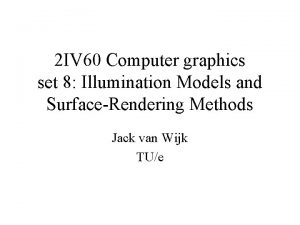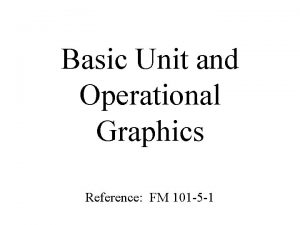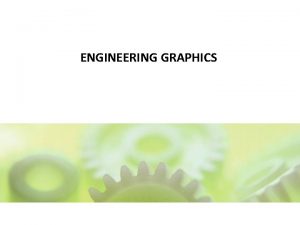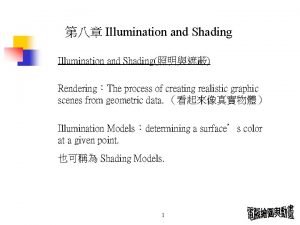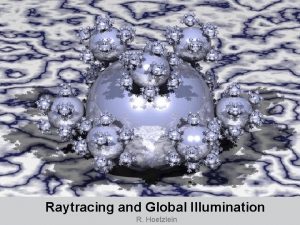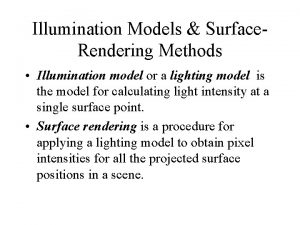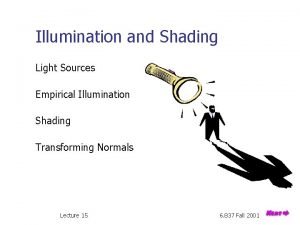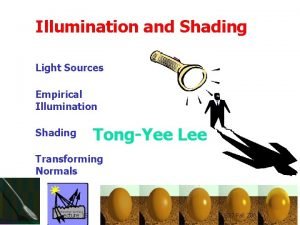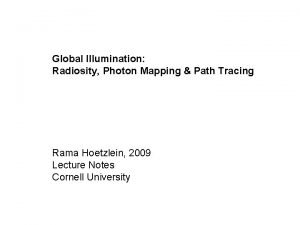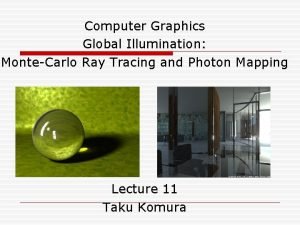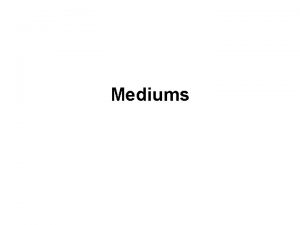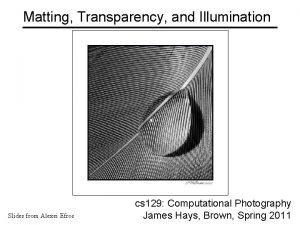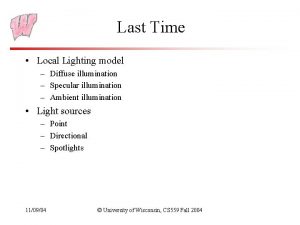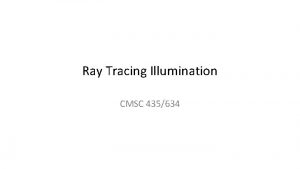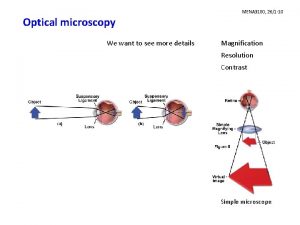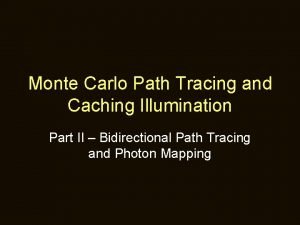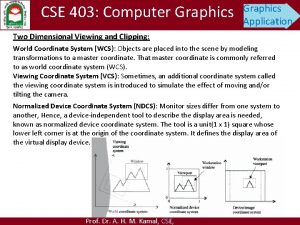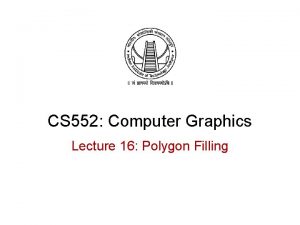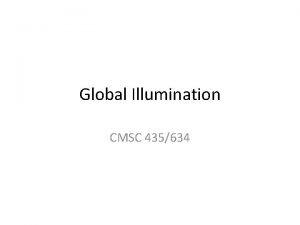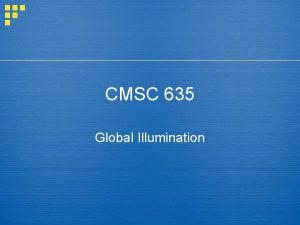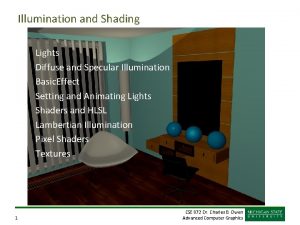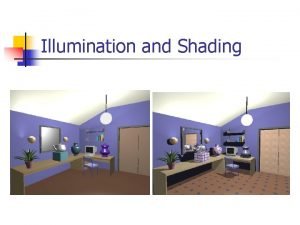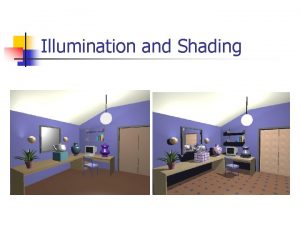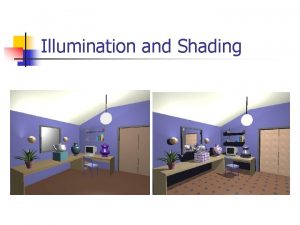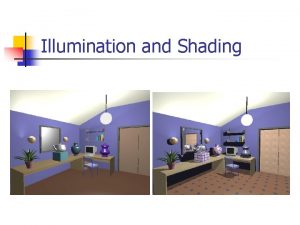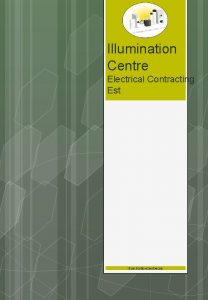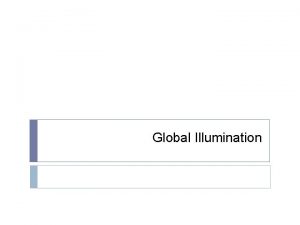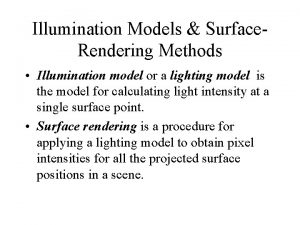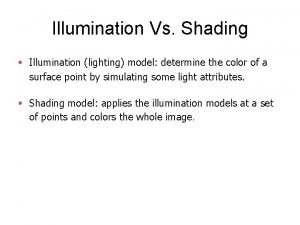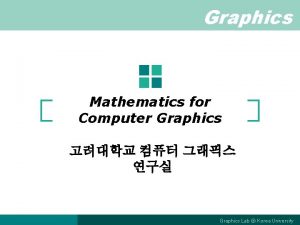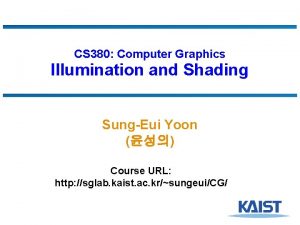Computer Graphics V Semester Unit 4 Illumination and






















![Open. GL Materials GLfloat white 8[] = {. 8, 1. }, white 2 = Open. GL Materials GLfloat white 8[] = {. 8, 1. }, white 2 =](https://slidetodoc.com/presentation_image_h/2ed616508f103832d16b71812fdc266e/image-23.jpg)
![Open. GL Lighting GLfloat white[] = {1. , 1. }; GLfloat light 0_position[] = Open. GL Lighting GLfloat white[] = {1. , 1. }; GLfloat light 0_position[] =](https://slidetodoc.com/presentation_image_h/2ed616508f103832d16b71812fdc266e/image-24.jpg)

















- Slides: 41

Computer Graphics V - Semester Unit – 4 Illumination and shading K. A. Dhamotharan, Assistant Professor ( Senior Grade)

Illumination and Shading

Illumination Vs. Shading § Illumination (lighting) model: determine the color of a surface point by simulating some light attributes. § Shading model: applies the illumination models at a set of points and colors the whole image.

Illumination (Lighting) Model • To model the interaction of light with surfaces to determine the final color & brightness of the surface – Global illumination – Local illumination

Global Illumination • Global Illumination models: take into account the interaction of light from all the surfaces in the scene.

Local illumination • Only consider the light, the observer position, and the object material properties

Basic Illumination Model • Simple and fast method for calculating surface intensity at a given point • Lighting calculation are based on: – The background lighting conditions – The light source specification: color, position

Ambient light (background light) • The light that is the result from the light reflecting off other surfaces in the environment • A general level of brightness for a scene that is independent of the light positions or surface directions -> ambient light • Has no direction • Each light source has an ambient light contribution, Ia • For a given surface, we can specify how much ambient light the surface can reflect using an ambient reflection coefficient : Ka (0 < Ka < 1)

Ambient Light • So the amount of light that the surface reflect is therefore Iamb = Ka * Ia

Diffuse Light • The illumination that a surface receives from a light source and reflects equally in all directions • This type of reflection is called Lambertian Reflection (thus, Lambertian surfaces) • The brightness of the surface is indepenent of the observer position (since the light is reflected in all direction equally)

Lambert’s Law • How much light the surface receives from a light source depends on the angle between its angle and the vector from the surface point to the light (light vector) • Lambert’s law: the radiant energy ’Id’ from a small surface da for a given light source is: Id = IL * cos(q) IL : the intensity of the light source q is the angle between the surface normal (N) and light vector (L)

The Diffuse Component • Surface’s material property: assuming that the surface can reflect Kd (0<Kd<1), diffuse reflection coefficient) amount of diffuse light: Idiff = Kd * IL * cos(q) If N and L are normalized, cos(q) = N*L Idiff = Kd * IL * (N*L) • The total diffuse reflection = ambient + diffuse Idiff = Ka * Ia + Kd * IL * (N*L)

Examples Sphere diffusely lighted from various angles !

Specular Light § These are the bright spots on objects (such as polished metal, apple. . . ) § Light reflected from the surface unequally to all directions. § The result of near total reflection of the incident light in a concentrated region around the specular reflection angle

Phong’s Model for Specular • How much reflection light you can see depends on where you are

Phong Illumination Curves Specular exponents are much larger than 1; Values of 100 are not uncommon. : glossiness, rate of falloff

Specular Highlights • Shiny surfaces change appearance when viewpoint is changed • Specularities are caused by microscopically smooth surfaces. • A mirror is a perfect specular reflector

Reflected Ray N L How to calculate R? R + L = 2(N*L) N R f f a V R = 2(N*L) N - L 2 N(N • L) L N(N • L) f Project L onto N L L f Double length of vector R = 2 N(N • L) - L f f Subtract L

Half Vector • An alternative way of computing phong lighting is: Is = ks * Is * (N*H)n • H (halfway vector): halfway between V and L: (V+L)/2 L • Fuzzier highlight N H V

Phong Illumination Moving Light Change n

Putting It All Together • Single Light (white light source)

Multiple Light Source • IL: light intensity • For multiple light sources – Repeat the diffuse and specular calculations for each light source – Add the components from all light sources – The ambient term contributes only once • The different reflectance coefficients can differ. – Simple “metal”: ks and kd share material color, – Simple plastic: ks is white • Remember, when cosine is negative lighting term is zero!
![Open GL Materials GLfloat white 8 8 1 white 2 Open. GL Materials GLfloat white 8[] = {. 8, 1. }, white 2 =](https://slidetodoc.com/presentation_image_h/2ed616508f103832d16b71812fdc266e/image-23.jpg)
Open. GL Materials GLfloat white 8[] = {. 8, 1. }, white 2 = {. 2, 1. }, black={0. , 0. }; GLfloat mat_shininess[] = {50. }; /* Phong exponent */ gl. Materialfv( GL_FRONT_AND_BACK, GL_AMBIENT, black); gl. Materialfv( GL_FRONT_AND_BACK, GL_DIFFUSE, white 8); gl. Materialfv( GL_FRONT_AND_BACK, GL_SPECULAR, white 2); gl. Materialfv( GL_FRONT_AND_BACK, GL_SHININESS, mat_shininess);
![Open GL Lighting GLfloat white 1 1 GLfloat light 0position Open. GL Lighting GLfloat white[] = {1. , 1. }; GLfloat light 0_position[] =](https://slidetodoc.com/presentation_image_h/2ed616508f103832d16b71812fdc266e/image-24.jpg)
Open. GL Lighting GLfloat white[] = {1. , 1. }; GLfloat light 0_position[] = {1. , 5. , 0. }; /* directional light (w=0) */ gl. Lightfv(GL_LIGHT 0, GL_POSITION, light 0_position); gl. Lightfv(GL_LIGHT 0, GL_DIFFUSE, white); gl. Lightfv(GL_LIGHT 0, GL_SPECULAR, white); gl. Enable(GL_LIGHT 0); gl. Enable(GL_NORMALIZE); /* normalize normal vectors */ gl. Light. Modeli(GL_LIGHT_MODEL_TWO_SIDE, GL_TRUE); /* two-sided lighting*/ gl. Enable(GL_LIGHTING);

Shading Models for Polygons § Constant Shading (flat shading) § Compute illumination at any one point on the surface. Use face or one normal from a pair of edges. Good for far away light and viewer or if facets approximate surface well. § Per-Pixel Shading § Compute illumination at every point on the surface. § Interpolated Shading § Compute illumination at vertices and interpolate color

Constant Shading • Compute illumination only at one point on the surface • Okay to use if all of the following are true – The object is not a curved (smooth) surface (e. g. a polyhedron object) – The light source is very far away (so N. L does not change much across a polygon) – The eye is very far away (so V. R does not change much across a polygon) – The surface is quite small (close to pixel size)

Un-lit

Flat Shading

Mach Band ?

Polygon Mesh Shading • Shading each polygonal facet individually will not generate an illusion of smooth curved surface • Reason: polygons will have different colors along the boundary, unfortunately, human perception helps to even accentuate the discontinuity: mach band effect

Mach Banding §Intensity change is exagerated §Dark facet looks darker and lighter looks even more lighter

Smooth Shading • Need to have per-vertex normals • Gouraud Shading – Interpolate color across triangles – Fast, supported by most of the graphics accelerator cards • Phong Shading – Interpolate normals across triangles – More accurate, but slow. Not widely supported by hardware

Gouraud Shading • Normals are computed at the polygon vertices • If we only have per-face normals, the normal at each vertex is the average of the normals of its adjacent faces • Intensity interpolation: linearly interpolate the pixel intensity (color) across a polygon surface

Linear Interpolation • Calculate the value of a point based on the distances to the point’s two neighbor points • If v 1 and v 2 are known, then x = b/(a+b) * v 1 + a/(a+b) * v 2

Linear Interpolation in a Triangle • To determine the intensity (color) of point P in the triangle, • we will do: • determine the intensity of 4 by linearly interpolating between 1 and 2 • determine the intensity of 5 by linearly interpolating between 2 and 3 • determine the intensity of P by linear interpolating between 4 and 5

Mach Band ?

Image

Phong Shading Model § Gouraud shading does not properly handle specular highlights, specially when the n parameter is large (small highlight). §Reason: colors are interpolated. §Solution: (Phong Shading Model) § 1. Compute averaged normal at vertices. § 2. Interpolate normals along edges and scan-lines. (component by component) § 3. Compute per-pixel illumination.



 Basic illumination models
Basic illumination models Computer graphics
Computer graphics Computer graphics chapter 1 ppt
Computer graphics chapter 1 ppt Basic unit of computer graphics
Basic unit of computer graphics Computer graphics unit 2 notes
Computer graphics unit 2 notes Incubation in creative process
Incubation in creative process Shahing
Shahing Chemistry semester 2 review unit 12 thermochemistry
Chemistry semester 2 review unit 12 thermochemistry Vray global illumination
Vray global illumination Tangential illumination
Tangential illumination Illumination
Illumination An improved illumination model for shaded display
An improved illumination model for shaded display Maze type entrance
Maze type entrance Illumination engineering notes pdf
Illumination engineering notes pdf In phong model, for dull surface assigned
In phong model, for dull surface assigned Light direction
Light direction Illumination formula
Illumination formula Global illumination radiosity
Global illumination radiosity Optical microscope
Optical microscope Jeffrey h. shapiro
Jeffrey h. shapiro Global illumination algorithms
Global illumination algorithms Poe global illumination
Poe global illumination Illumination
Illumination Local illumination model
Local illumination model Laser illumination of aircraft
Laser illumination of aircraft Direct illumination
Direct illumination Ambient occlusion definition
Ambient occlusion definition Advanced global illumination
Advanced global illumination Illumination
Illumination Posterior subcapsular cataract
Posterior subcapsular cataract Illumination concepts
Illumination concepts Kohler illumination system
Kohler illumination system Global illumination vray
Global illumination vray Illumination monaco
Illumination monaco Interior and exterior clipping in computer graphics
Interior and exterior clipping in computer graphics Bresenham line drawing algorithm in computer graphics
Bresenham line drawing algorithm in computer graphics Points and lines in computer graphics ppt
Points and lines in computer graphics ppt What is window and viewport in computer graphics
What is window and viewport in computer graphics Shear transformation in computer graphics
Shear transformation in computer graphics Mathematical foundations of computer graphics and vision
Mathematical foundations of computer graphics and vision Computer graphics chapter 1 ppt
Computer graphics chapter 1 ppt Boundary fill algorithm in computer graphics
Boundary fill algorithm in computer graphics
